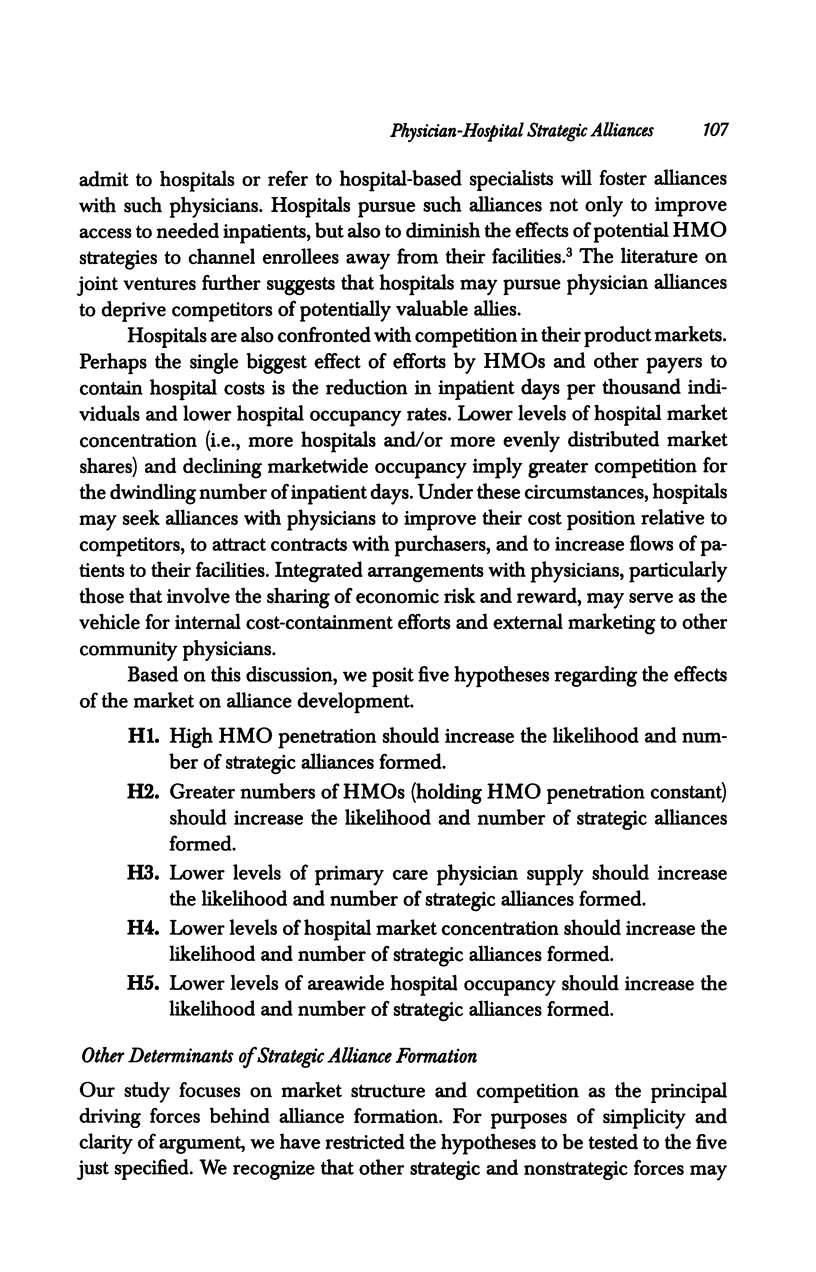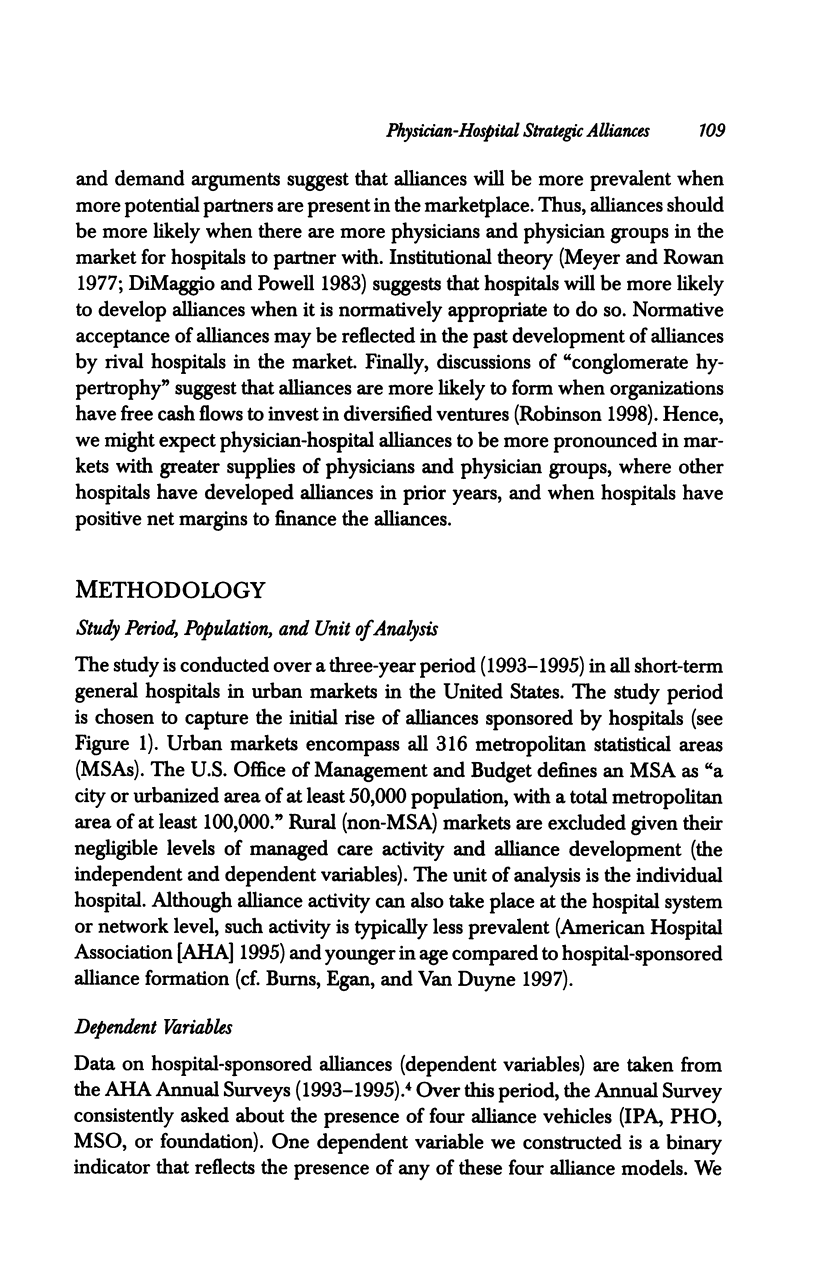Abstract
OBJECTIVE: To assess the impact of HMO market structure on the formation of physician-hospital strategic alliances from 1993 through 1995. The two trends, managed care and physician-hospital integration have been prominent in reshaping insurance and provider markets over the past decade. STUDY DESIGN: Pooled cross-sectional data from the InterStudy HMO Census and the Annual Survey conducted by the American Hospital Association (AHA) between 1993 and the end of 1995 to examine the effects of HMO penetration and HMO numbers in a market on the formation of hospital-sponsored alliances with physicians. Because prior research has found nonlinear effects of HMOs on a variety of dependent variables, we operationalized HMO market structure two ways: using a Taylor series expansion and cross-classifying quartile distributions of HMO penetration and numbers into 16 dummy indicators. Alliance formation was operationalized using the presence of any alliance model (IPA, PHO, MSO, and foundation) and the sum of the four models present in the hospital. Because managed care and physician-hospital integration are endogenous (e.g., some hospitals also sponsor HMOs), we used an instrumental variables approach to model the determinants of HMO penetration and HMO numbers. These instruments were then used with other predictors of alliance formation: physician supply characteristics, the extent of hospital competition, hospital-level descriptors, population size and demographic characteristics, and indicators for each year. All equations were estimated at the MSA level using mixed linear models and first-difference models. PRINCIPAL FINDINGS: Contrary to conventional wisdom, alliance formation is shaped by the number of HMOs in the market rather than by HMO penetration. This confirms a growing perception that hospital-sponsored alliances with physicians are contracting vehicles for managed care: the greater the number of HMOs to contract with, the greater the development of alliances. The models also show that alliance formation is low in markets where a small number of HMOs have deeply penetrated the market. First-difference models further show that alliance formation is linked to HMO consolidation (drop in the number of HMOs in a market) and hospital downsizing. Alliance formation is not linked to changes in hospital costs, profitability, or market competition with other hospitals. CONCLUSIONS: Hospitals appear to form alliances with physicians for several reasons. Alliances serve to contract with the growing number of HMOs, to pose a countervailing bargaining force of providers in the face of HMO consolidation, and to accompany hospital downsizing and restructuring efforts. IMPLICATIONS FOR POLICY, DELIVERY, OR PRACTICE: Physician-hospital integration is often mentioned as a provider response to increasing cost-containment pressures due to rising managed care penetration. Our findings do not support this view. Alliances appear to serve the hospital's interest in bargaining with managed care plans on a more even basis.
Full text
PDF































Images in this article
Selected References
These references are in PubMed. This may not be the complete list of references from this article.
- Bazzoli G. J., Marx D., Jr, Arnould R. J., Manheim L. M. Federal antitrust merger enforcement standards: a good fit for the hospital industry? J Health Polit Policy Law. 1995 Spring;20(1):137–169. doi: 10.1215/03616878-20-1-137. [DOI] [PubMed] [Google Scholar]
- Burns L. R., Bazzoli G. J., Dynan L., Wholey D. R. Managed care, market stages, and integrated delivery systems: is there a relationship? Health Aff (Millwood) 1997 Nov-Dec;16(6):204–218. doi: 10.1377/hlthaff.16.6.204. [DOI] [PubMed] [Google Scholar]
- Burns L. R., Morrisey M. A., Alexander J. A., Johnson V. Managed care and processes to integrate physicians/hospitals. Health Care Manage Rev. 1998 Fall;23(4):70–80. doi: 10.1097/00004010-199810000-00006. [DOI] [PubMed] [Google Scholar]
- Burns L. R., Wholey D. R. Adoption and abandonment of matrix management programs: effects of organizational characteristics and interorganizational networks. Acad Manage J. 1993 Feb;36(1):106–138. [PubMed] [Google Scholar]
- Dynan L., Bazzoli G. J., Burns R. Assessing the extent of integration achieved through physician-hospital arrangements. J Healthc Manag. 1998 May-Jun;43(3):242–262. [PubMed] [Google Scholar]
- Garnick D. W., Luft H. S., Robinson J. C., Tetreault J. Appropriate measures of hospital market areas. Health Serv Res. 1987 Apr;22(1):69–89. [PMC free article] [PubMed] [Google Scholar]
- Makuc D. M., Haglund B., Ingram D. D., Kleinman J. C., Feldman J. J. The use of health service areas for measuring provider availability. J Rural Health. 1991;7(4 Suppl):347–356. [PubMed] [Google Scholar]
- Morrisey M. A., Alexander J., Burns L. R., Johnson V. The effects of managed care on physician and clinical integration in hospitals. Med Care. 1999 Apr;37(4):350–361. doi: 10.1097/00005650-199904000-00005. [DOI] [PubMed] [Google Scholar]
- Robinson J. C. Financial capital and intellectual capital in physician practice management. Health Aff (Millwood) 1998 Jul-Aug;17(4):53–74. doi: 10.1377/hlthaff.17.4.53. [DOI] [PubMed] [Google Scholar]
- Wholey D., Feldman R., Christianson J. B. The effect of market structure on HMO premiums. J Health Econ. 1995 May;14(1):81–105. doi: 10.1016/0167-6296(94)00039-7. [DOI] [PubMed] [Google Scholar]
- Zuckerman H. S., Hilberman D. W., Andersen R. M., Burns L. R., Alexander J. A., Torrens P. Physicians and organizations: strange bedfellows or a marriage made in heaven? Front Health Serv Manage. 1998 Spring;14(3):3–34. [PubMed] [Google Scholar]



